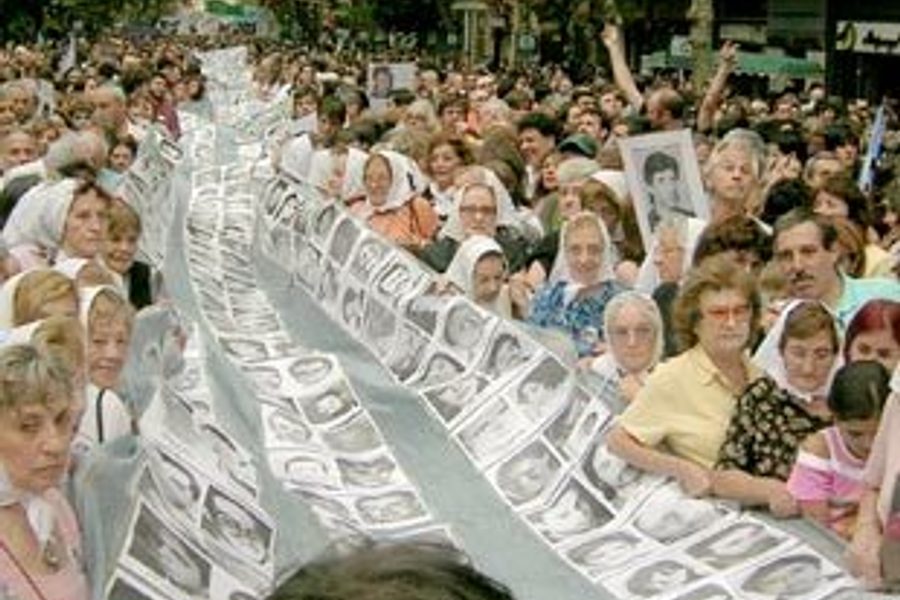
Step into the small offices of the Archive for Permanent Memory (Archivo Permanente Para La Memoria) and follow the main hallway to reach a cramped room divided up by computer stations, shelves that hold meticulously organized stacks of binders, boxes of cassettes and discs, and a gaggle of stereos and audio recording equipment. Pictures of smiling young people dot the walls.
“This is my mother, and here is my father,” says Lorena Battistiol, pointing to a poster with a smattering of black and white passport-type photos. “They were disappeared in 1977 when I was one year old. We are still looking for my younger brother – or sister. We know my mother gave birth in captivity, we just don’t know if it was a boy or a girl.”
Battistiol, 30, is one of the few full-time employees at the Archive, where the lives of people cut short by state terror are being pieced together and archived in the hopes that one day their missing children will have a chance to learn about the parents they never knew. The Grandmothers of the Plaza de Mayo, the pioneering Argentine human rights group, inaugurated the Archive in 1998 with help from the University of Buenos Aires.
Case by case, family members and friends are interviewed, old photographs are collected and filed, family trees compiled. The finished product is a confidential folio of transcribed interviews, cassettes, and discs of digitized photographs, which staff members hope to give to the missing children of the disappeared, when or if they are ever located. “When a child is found, the Grandmothers have a ceremony where they present the book,” Battistiol says. “It’s really an incredibly emotional moment.”
To recap the tragedy: In 1976 a troika of right-wing generals, among them graduates of the U.S. Army School of the Americas, staged a coup and implemented a bloody campaign to eradicate “subversion” and to eliminate opposition to the implementation of a conservative economic regime.
Tens of thousand of Argentines were detained, tortured and buried in mass graves or thrown alive into the ocean during regular death flights. What sets this story apart from other similarly brutal Latin American dictatorships of the ’70s and the ’80s is what they did to the children of the disappeared.
Up to 500 children of desaparecidos, some born to imprisoned mothers and others only babies when they were kidnapped along with their parents, were given away, mostly to police and military families. Birth certificates were falsified and names were changed. To date, 82 of these children have been identified.
Juan Cabandie, 28, is one of them – the 77th “found” child. For 26 years Cabandie was Mariano Falco. After becoming estranged from his abusive father, a policeman and former intelligence agent of the dictatorship, and spending years having nagging doubts about his identity, Cabandie approached the Grandmothers of Plaza de Mayo after seeing one of their TV spots that asked, “Do you know who you really are?”
In 2004, a blood test confirmed that Cabandie was the son of Alicia Elena Alfonsín and Damián Abel Cabandie, both last seen alive in 1978 at ESMA (Army School of Mechanics), one of the largest of 480 concentration camps operated during the dictatorship. Through the memory book created at the Archive he learned the details of his birth as reported by survivors of ESMA who shared a cell with Alicia, his mother.
“I was born here at the ESMA. I spent only 15 days here with my mother before they took her away,” Cabandie told a crowd of thousands gathered around a stage set up in front of the school. “With us they thought they could destroy the memories and the hopes of our parents, who fought for a better future, for a country where there aren’t millions of people socially disappeared by poverty and hunger, like the country we have now.”
Cabandie addressed the crowd on March 24 – the 30th anniversary of the military coup, recently declared a national day of memory by the government of President Nestor Kirchner. A year earlier, the former concentration camp was designated a museum of memory and will soon be open to the public. It is one sign that the wheels of justice are beginning to move in Argentina, albeit slowly.
Last fall, a renovated Argentine Supreme Court struck down the amnesty laws that protected the military for decades, and federal prosecutors are now preparing hundreds of “mega-cases” against retired military officials. Weekly hearings in the capital have begun to record the sworn testimony of survivors and witnesses of those bloody years.
“I am here as proof that they didn’t succeed,” says Cabandie, “that their macabre plan of robbing babies won’t succeed, and that even over the bodies of 30,000 disappeared Argentines, their plan won’t succeed.”






